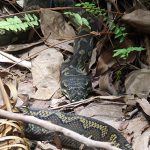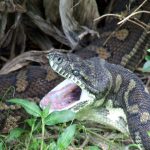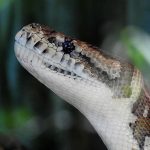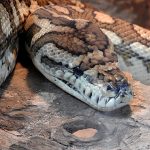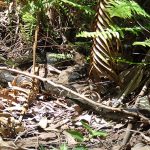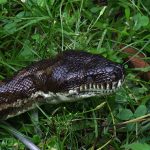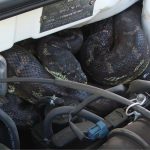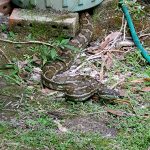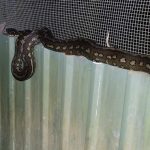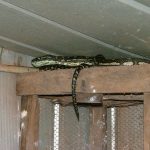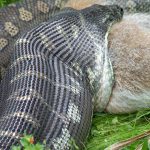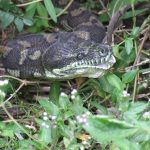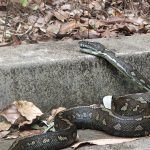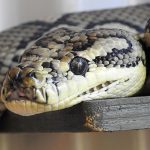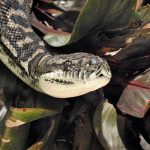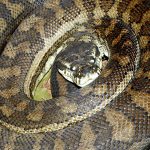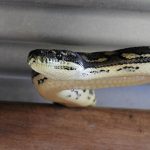COASTAL CARPET PYTHON
Coastal Carpet Python (Morelia spilota mcdowelli)
In the lush landscapes of eastern Queensland and northeastern New South Wales, a remarkable creature slithers through the underbrush and climbs the towering trees—the Coastal Carpet Python (Morelia spilota mcdowelli). This non-venomous snake, often referred to as the Carpet Snake, is a master of adaptation, thriving in diverse habitats from dense rainforests to suburban backyards.
Physical Characteristics
Imagine a snake with a robust, muscular body adorned in a tapestry of colours. The Coastal Carpet Python’s skin is a mosaic of olive to black hues, interspersed with yellow or cream blotches and crossbands, creating a pattern reminiscent of an intricate carpet. Its underside is predominantly white to cream. The head is distinct from the neck, featuring deeply pitted scales along the jawline and small, granular scales on top of the head. Typically, these pythons measure around 2.1 metres in length, though some individuals can exceed 3 metres, with the largest recorded specimen reaching 4.2 metres.
Habitat and Distribution
The Coastal Carpet Python is a versatile inhabitant, occupying a range of environments from rainforests and wet sclerophyll forests to dry woodlands and even urban areas. In suburban settings, they often find refuge in roof and wall cavities, sheds, and garages, as well as in the dense foliage of trees and shrubs. Their adaptability allows them to coexist with human populations, sometimes even residing in the periphery of highly disturbed farmland.
Behaviour
Primarily nocturnal, the Coastal Carpet Python is an adept climber, often found draped across tree branches or coiled in undergrowth.
Coastal Carpet Pythons and Brumation
Coastal Carpet Pythons do not hibernate but enter a state of brumation during the cooler months. This means they become less active, and their metabolism slows down. However, they do not remain completely inactive and may still be seen basking on warm days.
Winter Activity
Even during brumation, Coastal Carpet Pythons may remain active, especially on warmer days. They often seek shelter in tree hollows, roof cavities, or other sheltered areas to maintain a stable body temperature.
While Coastal Carpet Pythons do not hibernate, they do enter a state of reduced activity during the cooler months. Understanding this behavior can help in coexisting with these fascinating creatures during winter.
Diet
Its diet is diverse, consisting mainly of mammals such as rodents and possums, but also including reptiles, birds, and frogs. In suburban areas, they may prey on small pets like dogs, cats, and guinea pigs, as well as caged birds.
Reproduction
During the breeding season, female Coastal Carpet Pythons lay a clutch of 25-50 eggs. They coil around the eggs to incubate them, maintaining a warm environment until the hatchlings emerge. The incubation period lasts approximately 65–70 days, after which the young snakes are independent and begin their journey into the world.
Interaction with Humans
While non-venomous, the Coastal Carpet Python possesses 70-100 curved teeth that it frequently replaces. Bites can cause significant lacerations or punctures, so it’s advisable to exercise caution and seek prompt medical attention if bitten. Despite their formidable appearance, these pythons are generally shy and prefer to avoid human contact. They play a crucial role in controlling populations of small mammals and other prey species, contributing to the ecological balance of their habitats.
Conservation Status
The Coastal Carpet Python is not currently listed as threatened. However, habitat destruction and human encroachment pose ongoing challenges. Conservation efforts focusing on habitat preservation and responsible human interactions are essential to ensure the continued health and stability of their populations.
Conclusion
The Coastal Carpet Python is a testament to nature’s ingenuity, seamlessly blending into a variety of environments and playing a vital role in maintaining ecological harmony. Its presence in both wild and suburban areas highlights the importance of understanding and respecting the wildlife that shares our spaces.

